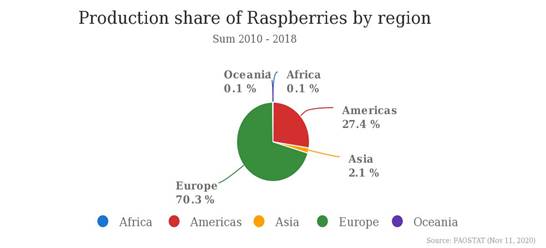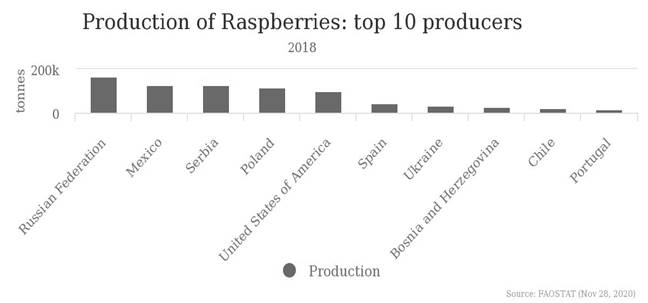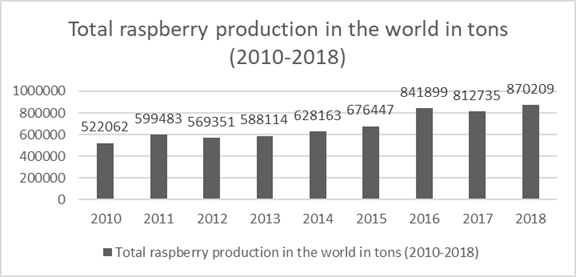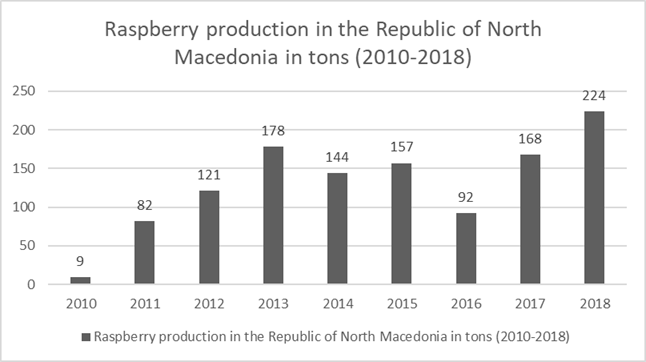|
|
|
|
ANALYSIS OF MARKET OPPORTUNITIES FOR RASPBERRY PRODUCTION IN THE REPUBLIC OF NORTH MACEDONIAKaterina
Bojkovska *1
|
|
|
|
Article Type: Research Article
Article Citation: Katerina
Bojkovska, Nikolce Jankulovski, Goran Mihajlovski, and Jovica Momirceski.
(2020). ANALYSIS OF MARKET OPPORTUNITIES FOR RASPBERRY PRODUCTION IN THE
REPUBLIC OF NORTH MACEDONIA. International Journal of Research -GRANTHAALAYAH, 8(12),
149-154. https://doi.org/10.29121/granthaalayah.v8.i12.2020.2698
Received Date: 07 November 2020
Accepted Date: 31 December 2020
Keywords:
Raspberry
Production
Market
Opportunities
Analysis
ABSTRACT
The purpose of the research in this paper is to analyze the production of raspberries in Republic of N. Macedonia and to perceive its place on the world market of raspberries, as well as to analyze the market opportunities for raspberry production in Republic of N. Macedonia.
The results of the research show that Russia occupies 19% of world raspberry production for 2018 while Mexico occupies 15% of total raspberry production and Serbia occupies 15% of total raspberry production for 2018, i.e., it is the third largest producer in the world. The production of raspberries worldwide has increased by 7% in 2018 compared to 2017, while compared to 2010 this production worldwide has increased by 40%.
Republic of N. Macedonia with its 33rd place occupies 0.03% of the total world production of raspberries in 2018 from a total of 45 countries. But despite the small share in world raspberry production in 2018, Republic of N. Macedonia records a drastic increase (by 96%) compared to 2010, while compared to 2017 it increased by 25%. Republic of N. Macedonia has the necessary conditions for the production of raspberries, but still this branch is not fully developed.
1. INTRODUCTION
Rich
yield, unlimited sales, high purchase prices and European earnings make growing
raspberries a profitable agribusiness.
Regarding
the ecological conditions, raspberry is a very specific crop and therefore,
before deciding to raise a plantation, it is necessary to analyze the
ecological conditions that largely determine the success of the plantations.
The best locations for raspberry plantations are in the beech zone, on hilly
and mountainous areas and at an altitude of 300 to 1000 m.The soil conditions
of the location are extremely important for the successful cultivation of the
plantations. This crop gives the best results on deep, loose, permeable,
slightly acidic soils with a pH of 5.5 to 6.5, and soils with a humus content
of 3 to 5%. Raspberries respond particularly poorly to shallow, light, dry,
calcareous, stony, highly acidic, alkaline, heavy and swampy soils.
The best conditions for raspberries
production are areas with temperate-continental climate, in moderately humid
and moderately warm areas without large temperature fluctuations. Of the
climatic elements of special importance are light, heat, precipitation and
wind. Raspberries do not tolerate shady places, but they do not tolerate places
exposed to a lot of sun. During the winter, raspberry shoots freeze at
temperatures below -18 ° C, especially if such low temperatures occur on frost.
Raspberries do not tolerate dry conditions. They thrive in areas with annual
rainfall of 700 to 1000 mm, half of which are during the growing season. If
there is not enough rainfall in the plantations, irrigation should be provided.
Raspberries also do not tolerate very windy locations.
Raspberry
is one of the most profitable fruit products. The economic importance of its
production is reflected in the high level of merchandising, competitiveness and
increasing demand for frozen raspberries in the market of the European Union
[1]. (Kljajić N. et. all., 2017,
pp.59).
Raspberries
represent a highly sought-after commodity in the world market. Apart from being
a delicious fruit that can be consumed without any further processing,
raspberries are an essential input when it comes to the production of juices,
jams, extracts and similar food and beverages (Stojković et. all., 2020,
pp. 956).
In the Republic of North Macedonia,
hilly and mountainous areas offer a huge untapped potential for growing raspberries.
Raspberries belong to the red
varieties of Rubus fruit with a red
color that are grown in Europe (European red raspberry), North America
(American variety) and many different varieties and varieties in Asia, i.e.,
the cultivation of R. hirsute in China.
Red raspberries are the fourth most important fruit product in the world.
"Vilamet" and
"Miker" are the most common varieties of raspberries in Republic of
North Macedonia. The first variety is characterized by high fertility and large
fruits, while the variety "mike" has a higher yield than
"vilamet" and matures a few days after it. It is widespread in the
forests of Europe, Asia and North America, and is also present in our country.
It is a profitable, economically important fruit crop, with early, abundant and
regular fruiting. But despite all the advantages, the production of raspberries
in the world is in short supply and does not meet the needs of the people.
2.
MATERIALS
AND METHODS
In this research are
used methods which can be considered a way to arrive at scientific data on the
phenomena in the society. For the purposes of this study, have been used
several scientific methods: The method of explanation, descriptive methods, the
methods of concretization, generalization and comparison of the data, inductive
and deductive method and methods of analysis and synthesis. Statistical method
is used whereby the statistical processing of the obtained data from the
research is interpreted, then analyzed, based on which appropriate conclusions
were drawn. Multiple sources were used for the research in this paper. Current
state and trends in the production of raspberry in Republic of North Macedonia
and in the world are perceived on the basis of statistical data downloaded from
websites and available statistical publications.
3.
RESULTS
AND DISCUSSIONS
Demand
for raspberries and blackberries has risen sharply in Europe and North America
in recent years. In the Western countries, raspberries are considered a luxury
product.

Figure 1: Production share of raspberries by region
(2010-2018)[1]
The data
obtained from FAOSTAT - Food and Agriculture Organization of the United
Nations, show that the largest production of raspberries is recorded in Europe
(70.3%), followed by the United States (27.4%). Raspberry production in Asia
(2.1%), Africa (0.1%) and Oceania (0.1%) are negligible for the period
2010-2018 (Figure 1).

Figure 2: Production of Raspberries: top 10 World
producers, tons, 2018[2]
The data in Figure 2 show that Russian Federation with a production of 165
800 tons of raspberries in 2018 occupies 19% of world production and is in
first place in the world in terms of raspberry production, Mexico is in second
place in terms of production of raspberries from 130 187 tons, and Serbia is on the
third place with the total production of raspberries of 127 010 tons for 2018,
and it is the third largest raspberry producer in the World.
Nearly one
quarter of the world’s total raspberry production is
generated in Serbia, with almost all of the production being exported (Šapić S. et. all., 2020, pp. 226)
Republic of North Macedonia, on the other hand, with the production of
raspberries of 224 tons in 2018 is on the 33rd place and occupies 0.03% of the
total world production of raspberries from a total of 45 countries. This is
probably due to insufficient support by state institutions responsible for
supporting raspberry production. Republic of North Macedonia has the necessary
conditions for the production of raspberries, but still this branch is not
fully developed in the country. Greater support is needed to motivate raspberry
growers, and ensure their product is marketed securely.
The world production of raspberries from 2010 to 2018 is increasing every
year, with the demand itself growing and therefore there is a need for
increasing production. Although in this period the world production has grown
by about 300 000 tons, every year there is a growing demand for the offered available quantity on the market.

Figure 3: Raspberry production in the World, quantity
in tons (2018)[3]
In this period, the largest world raspberry production is evidenced in 2018 with 870209 tons while the lowest production is
in 2010 with a total world production of 522 062 tons (Figure 3).
In 2017, the area of land planted
with raspberries is a total of 118 219 hectares. According to the area of raspberries planted in 2017, in first place is
Poland with 29,317 hectares of land planted with raspberries, followed by
Serbia with 21 861 hectares and in third place is Russia with 20 185 hectares
of land planted with raspberries, due to primarily due to the ideal climatic and
soil conditions in these countries that enable good raspberry production as
well as the export policies that these countries have which makes production
favorable for producers.As much as 25% of the total area on which raspberries
are produced in the world belongs to Poland to 18% belongs to Serbia and 17% to
Russia while Macedonia participates with 0.024% in the total area planted with
raspberries in the world[4].

Figure 4: Raspberry production in the Republic of
North Macedonia in tons (2010-2018)[5]
Despite
the relatively small production of raspberries in the Republic of North
Macedonia, in 2018 there was a significant increase in raspberry production (by
96%) compared to 2010. In the analyzed period, there is an increase in the
amount of raspberry production from year to year. In 2018, the production of
raspberries increased by 215 tons compared to 2010 when only 9 tons of
raspberries were produced (Figure 4).
In terms
of yield, it is noticeable that in Republic of North Macedonia, the yield of
raspberries over the years has quite a significant fluctuation with the highest
yields in 2010 with 90,000 hg / hectare so that every next year this number
experiences a significant decrease until 2016 when it has the lowest value, i.e.,
it reaches 43 810 hg/hectare, which is 51% less compared to 2010. In 2017, the
yield of raspberries increased again by 27% compared to 2016[6].
The
growth, profitability and competitiveness of the sector must be improved
through investments in all phases (production, processing and distribution) and
changes in the export structure. Product
packaging, design and transportation should be improved especially
for the export markets (Milić D. et. all., pp.167)
This increase in the yield of raspberries in Republic of North Macedonia in
2017 compared to the previous year is presumed to be due to the improvement of
the conditions for production of raspberries in Republic of North Macedonia,
i.e. increased support for raspberry growers as well as with increase in the
number of subcontractors that work together as agricultural cooperatives for
the production of raspberries, which for one hectare (10.000 square meters) of
raspberry plantations, have an initial investment of only one euro, as a result
of numerous projects to support agricultural production but also due reducing
the price of seedlings. This reduced the producers' initial investment, which
made this an attractive business for them. In practice, this is an investment
of about 10.000 euros per hectare, which is actually twice as small because a
state subsidy can be used to build new orchards, which is 50% of the
investment. This means that the real investment costs 5.000 euros. From the
first harvest, which is a year and a half after planting raspberries, if grown
as prescribed, there will be a yield of about 20 tons. Those 20.000 kilograms,
if sold at a price of one euro, as much as last year, is 20.000 euros. Of this
amount, about 6.000 euros are for the collectors, and the remaining 14.000
euros are net earnings because the state subsidizes the maintenance of the
plantations themselves. This is expected to follow this trend of increasing
raspberry production in Republic of North Macedonia in the future. Macedonia
especially with the increase and the sale and export of raspberries produced in
Republic of North Macedonia that are in demand on the market due to their
unique quality and bliss.
Intensive
raspberry production requires organized approach to improving product quality,
increasing the economic efficiency of primary production and processing as well
as the active role of the state (providing loans for production of exported
commodities under favorable conditions, protection of raspberry as a product of
national interest, etc.) (Kljajić N., 2017, pp. 46).
4.
CONCLUSION
Unfortunately in Republic of North Macedonia agriculture producers are still not
interested in growing raspberries, because it is not in line with the
Macedonian tradition. Although in this country there are favorable soil and
climatic conditions for its cultivation, it is a deficient fruit crop. It is
grown on an area of several
hectares. Considering the requirements of this crop in terms of ecological
conditions, appropriate regionalization has not been performed, i.e. raspberry plantations
have been established in areas that are not very favorable for its development
and fertility. Yield per unit area is quite low, despite the biological
potential of the crop. With appropriate agro and technical measures provide a
yield of over 20 tons/ha. There are other reasons for the low yield, such as:
use of inappropriate assortment, lack of tradition for growing raspberries,
inadequate agricultural techniques, insufficient supply of labor for growing
and harvesting, low purchase prices, etc.
Given the high market demand on the one hand and the lack of fruit on the
other hand, in the future its production should be intensified, which can be
achieved by solving the above-mentioned disadvantages such as: introduction of
high quality varieties and varieties for mechanized fruit harvesting, zoning or
cultivation of raspberries in appropriate climatic and soil conditions, use of
quality planting material, application of appropriate agro-techniques and new technologies
in production. It is especially important that the appropriate trade
organizations with fruit seedlings, etc., agree on prices with producers and
that there are guaranteed purchase prices, which will ensure greater stability
of raspberry production. Nothing will be achieved if there is no fair
relationship and good cooperation and agreement between manufacturers.
Farmers who want to grow raspberries need to make the right choice of
varieties and the right choice of region. The choice of variety is the most
important factor for successful raspberry production. More than 1000 varieties
have been created, but the number of economically significant varieties is
small. In terms of assortment, among the leading varieties of raspberries are
the homogeneous varieties "Vilamet" and "Miker". Planting
material of all two varieties in Republic of North Macedonia produces only the Agricultural
Institute in Skopje. If the farmer wants to import material from other
wholesale varieties, they should be entered in the National Variety List.
As a conclusion from all this it can be said that in the future in Reublic
of North Macedonia is expected to increase the yield of raspberries as a result
of improving the conditions for raspberry production, ie increasing the support
of raspberry growers in the country. The increase in the number of
subcontractors that function together as agricultural cooperatives for
raspberry production also contributes to all this.
SOURCES OF FUNDING
This
research received no specific grant from any funding agency in the public,
commercial, or not-for-profit sectors.
CONFLICT OF INTEREST
The
author have declared that no competing interests exist.
ACKNOWLEDGMENT
None.
REFERENCES
[1] Beekwilder J., Jonker H., Meesters
P., Hall R.D., I.M. van der Meer and C.H.R. de Vos (2005). Antioxidants in
raspberry: On-line analysis links antioxidant activity to a diversity of
individual metabolites. Journal of Agricultural and Food Chemistry 53,
3313–3320.
[2] Cerda B., Tomas Barberan F.A.,
Espin J.C. (2005). Metabolism of antioxidant and chemopreventive ellagitannins
fromstrawberries, raspberries, walnuts, and oak-aged wine in humans:
Identification of biomarkers and individual variability. Journal of
Agricultural and Food Chemistry 53, 227–235.
[3] Kljajić N., Sibic J.,
Sredojevic Z. (2017). Profitability of raspberry production on holdings in the
territory of Arilje, Economics of agriculture, 64(1):57-68
[4] Kljajić N. (2017). Production
and export of raspberry from the Republic of Serbia, Economics, 63(2): 45–53. DOI: 10.5937/ekonomika1702045k.
[5] Milić D., Sredojević Z.,
Lukač Bulatović M. (2017). Sustainability organizational-economic
model of value chain organic raspberry, Journal on Processing and Energy in
Agriculture, 21(3):163-167
[6] Stojkovic D., Zivic F., Stimac M.,
Borisavljevic K., Grujovic N. (2020). Raspberry as a potential commodity
exchange material in the republic of Serbia, Economics of agriculture
67(3):955-971
[7] Šapić S., Jaksic M.,
Stojkovic D. (2020). The raspberry commodity exchange in Serbia: An exploratory
research of producers' attitudes, Economics of the companies, 68(3-4): 215-228.
[1] Source: Author’s research according to data from www.fao.org
http://www.fao.org/faostat/en/#data/QC/visualize
[2] Source: Author’s research according to data from www.fao.org
http://www.fao.org/faostat/en/#data/QC/visualize
[3] Source: Author’s research according to data from www.fao.org
http://www.fao.org/faostat/en/#data/QC/visualize
[5]
Source: Author’s research
according to data from www.fao.org
http://www.fao.org/faostat/en/#data/QC/visualize
|
|
 This work is licensed under a: Creative Commons Attribution 4.0 International License
This work is licensed under a: Creative Commons Attribution 4.0 International License
© Granthaalayah 2014-2020. All Rights Reserved.


